Zheng Chang
AIGC-assisted Federated Learning for Edge Intelligence: Architecture Design, Research Challenges and Future Directions
Mar 26, 2025Abstract:Federated learning (FL) can fully leverage large-scale terminal data while ensuring privacy and security, and is considered as a distributed alternative for the centralized machine learning. However, the issue of data heterogeneity poses limitations on FL's performance. To address this challenge, artificial intelligence-generated content (AIGC) which is an innovative data synthesis technique emerges as one potential solution. In this article, we first provide an overview of the system architecture, performance metrics, and challenges associated with AIGC-assistant FL system design. We then propose the Generative federated learning (GenFL) architecture and present its workflow, including the design of aggregation and weight policy. Finally, using the CIFAR10 and CIFAR100 datasets, we employ diffusion models to generate dataset and improve FL performance. Experiments conducted under various non-independent and identically distributed (non-IID) data distributions demonstrate the effectiveness of GenFL on overcoming the bottlenecks in FL caused by data heterogeneity. Open research directions in the research of AIGC-assisted FL are also discussed.
IIMedGPT: Promoting Large Language Model Capabilities of Medical Tasks by Efficient Human Preference Alignment
Jan 06, 2025Abstract:Recent researches of large language models(LLM), which is pre-trained on massive general-purpose corpora, have achieved breakthroughs in responding human queries. However, these methods face challenges including limited data insufficiency to support extensive pre-training and can not align responses with users' instructions. To address these issues, we introduce a medical instruction dataset, CMedINS, containing six medical instructions derived from actual medical tasks, which effectively fine-tunes LLM in conjunction with other data. Subsequently, We launch our medical model, IIMedGPT, employing an efficient preference alignment method, Direct preference Optimization(DPO). The results show that our final model outperforms existing medical models in medical dialogue.Datsets, Code and model checkpoints will be released upon acceptance.
Age-Based Device Selection and Transmit Power Optimization in Over-the-Air Federated Learning
Jan 03, 2025



Abstract:Recently, over-the-air federated learning (FL) has attracted significant attention for its ability to enhance communication efficiency. However, the performance of over-the-air FL is often constrained by device selection strategies and signal aggregation errors. In particular, neglecting straggler devices in FL can lead to a decline in the fairness of model updates and amplify the global model's bias toward certain devices' data, ultimately impacting the overall system performance. To address this issue, we propose a joint device selection and transmit power optimization framework that ensures the appropriate participation of straggler devices, maintains efficient training performance, and guarantees timely updates. First, we conduct a theoretical analysis to quantify the convergence upper bound of over-the-air FL under age-of-information (AoI)-based device selection. Our analysis further reveals that both the number of selected devices and the signal aggregation errors significantly influence the convergence upper bound. To minimize the expected weighted sum peak age of information, we calculate device priorities for each communication round using Lyapunov optimization and select the highest-priority devices via a greedy algorithm. Then, we formulate and solve a transmit power and normalizing factor optimization problem for selected devices to minimize the time-average mean squared error (MSE). Experimental results demonstrate that our proposed method offers two significant advantages: (1) it reduces MSE and improves model performance compared to baseline methods, and (2) it strikes a balance between fairness and training efficiency while maintaining satisfactory timeliness, ensuring stable model performance.
Movable Antenna-Equipped UAV for Data Collection in Backscatter Sensor Networks: A Deep Reinforcement Learning-based Approach
Nov 21, 2024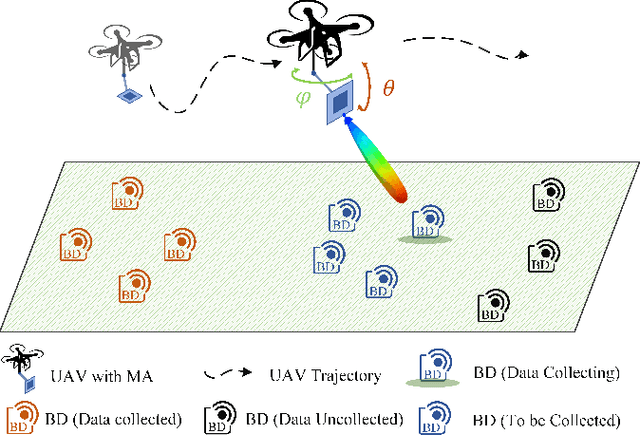
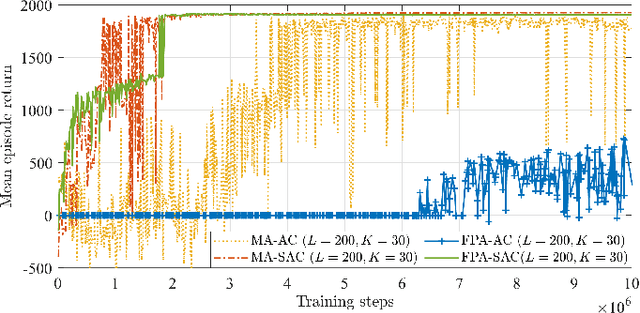
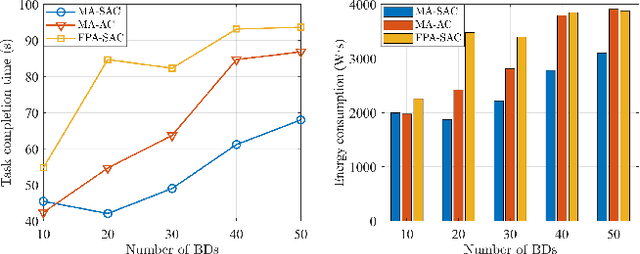

Abstract:Backscatter communication (BC) becomes a promising energy-efficient solution for future wireless sensor networks (WSNs). Unmanned aerial vehicles (UAVs) enable flexible data collection from remote backscatter devices (BDs), yet conventional UAVs rely on omni-directional fixed-position antennas (FPAs), limiting channel gain and prolonging data collection time. To address this issue, we consider equipping a UAV with a directional movable antenna (MA) with high directivity and flexibility. The MA enhances channel gain by precisely aiming its main lobe at each BD, focusing transmission power for efficient communication. Our goal is to minimize the total data collection time by jointly optimizing the UAV's trajectory and the MA's orientation. We develop a deep reinforcement learning (DRL)-based strategy using the azimuth angle and distance between the UAV and each BD to simplify the agent's observation space. To ensure stability during training, we adopt Soft Actor-Critic (SAC) algorithm that balances exploration with reward maximization for efficient and reliable learning. Simulation results demonstrate that our proposed MA-equipped UAV with SAC outperforms both FPA-equipped UAVs and other RL methods, achieving significant reductions in both data collection time and energy consumption.
Model Partition and Resource Allocation for Split Learning in Vehicular Edge Networks
Nov 11, 2024



Abstract:The integration of autonomous driving technologies with vehicular networks presents significant challenges in privacy preservation, communication efficiency, and resource allocation. This paper proposes a novel U-shaped split federated learning (U-SFL) framework to address these challenges on the way of realizing in vehicular edge networks. U-SFL is able to enhance privacy protection by keeping both raw data and labels on the vehicular user (VU) side while enabling parallel processing across multiple vehicles. To optimize communication efficiency, we introduce a semantic-aware auto-encoder (SAE) that significantly reduces the dimensionality of transmitted data while preserving essential semantic information. Furthermore, we develop a deep reinforcement learning (DRL) based algorithm to solve the NP-hard problem of dynamic resource allocation and split point selection. Our comprehensive evaluation demonstrates that U-SFL achieves comparable classification performance to traditional split learning (SL) while substantially reducing data transmission volume and communication latency. The proposed DRL-based optimization algorithm shows good convergence in balancing latency, energy consumption, and learning performance.
L-C4: Language-Based Video Colorization for Creative and Consistent Color
Oct 07, 2024



Abstract:Automatic video colorization is inherently an ill-posed problem because each monochrome frame has multiple optional color candidates. Previous exemplar-based video colorization methods restrict the user's imagination due to the elaborate retrieval process. Alternatively, conditional image colorization methods combined with post-processing algorithms still struggle to maintain temporal consistency. To address these issues, we present Language-based video Colorization for Creative and Consistent Colors (L-C4) to guide the colorization process using user-provided language descriptions. Our model is built upon a pre-trained cross-modality generative model, leveraging its comprehensive language understanding and robust color representation abilities. We introduce the cross-modality pre-fusion module to generate instance-aware text embeddings, enabling the application of creative colors. Additionally, we propose temporally deformable attention to prevent flickering or color shifts, and cross-clip fusion to maintain long-term color consistency. Extensive experimental results demonstrate that L-C4 outperforms relevant methods, achieving semantically accurate colors, unrestricted creative correspondence, and temporally robust consistency.
Adaptive and Parallel Split Federated Learning in Vehicular Edge Computing
May 29, 2024Abstract:Vehicular edge intelligence (VEI) is a promising paradigm for enabling future intelligent transportation systems by accommodating artificial intelligence (AI) at the vehicular edge computing (VEC) system. Federated learning (FL) stands as one of the fundamental technologies facilitating collaborative model training locally and aggregation, while safeguarding the privacy of vehicle data in VEI. However, traditional FL faces challenges in adapting to vehicle heterogeneity, training large models on resource-constrained vehicles, and remaining susceptible to model weight privacy leakage. Meanwhile, split learning (SL) is proposed as a promising collaborative learning framework which can mitigate the risk of model wights leakage, and release the training workload on vehicles. SL sequentially trains a model between a vehicle and an edge cloud (EC) by dividing the entire model into a vehicle-side model and an EC-side model at a given cut layer. In this work, we combine the advantages of SL and FL to develop an Adaptive Split Federated Learning scheme for Vehicular Edge Computing (ASFV). The ASFV scheme adaptively splits the model and parallelizes the training process, taking into account mobile vehicle selection and resource allocation. Our extensive simulations, conducted on non-independent and identically distributed data, demonstrate that the proposed ASFV solution significantly reduces training latency compared to existing benchmarks, while adapting to network dynamics and vehicles' mobility.
L-CAD: Language-based Colorization with Any-level Descriptions
May 26, 2023



Abstract:Language-based colorization produces plausible and visually pleasing colors under the guidance of user-friendly natural language descriptions. Previous methods implicitly assume that users provide comprehensive color descriptions for most of the objects in the image, which leads to suboptimal performance. In this paper, we propose a unified model to perform language-based colorization with any-level descriptions. We leverage the pretrained cross-modality generative model for its robust language understanding and rich color priors to handle the inherent ambiguity of any-level descriptions. We further design modules to align with input conditions to preserve local spatial structures and prevent the ghosting effect. With the proposed novel sampling strategy, our model achieves instance-aware colorization in diverse and complex scenarios. Extensive experimental results demonstrate our advantages of effectively handling any-level descriptions and outperforming both language-based and automatic colorization methods. The code and pretrained models are available at: https://github.com/changzheng123/L-CAD.
STIP: A SpatioTemporal Information-Preserving and Perception-Augmented Model for High-Resolution Video Prediction
Jun 09, 2022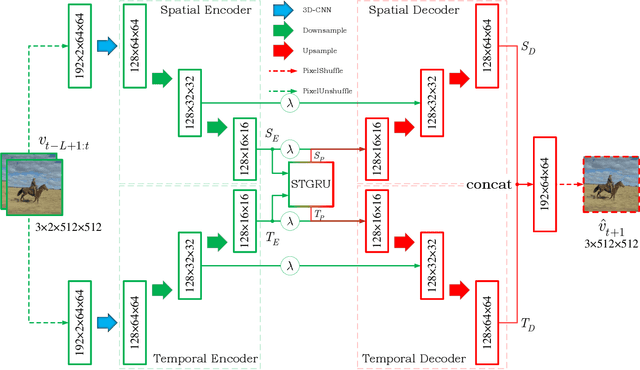


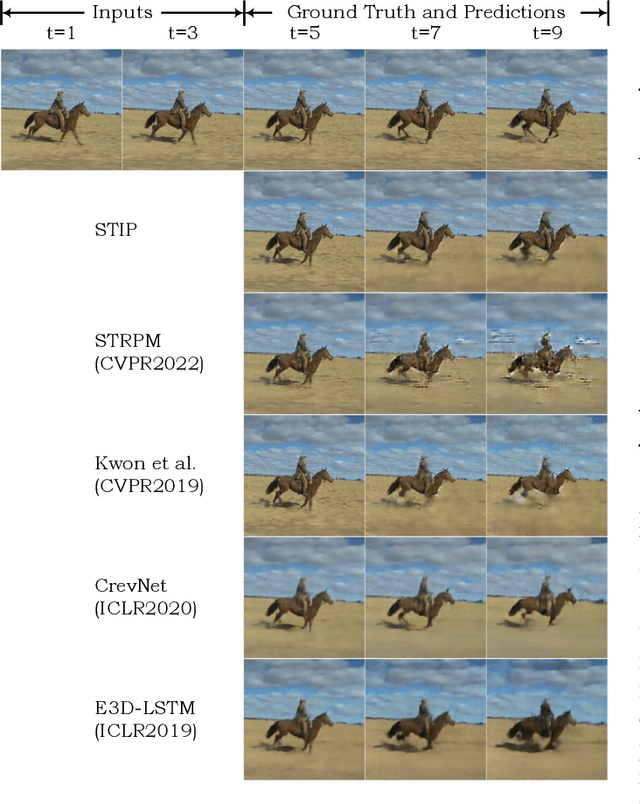
Abstract:Although significant achievements have been achieved by recurrent neural network (RNN) based video prediction methods, their performance in datasets with high resolutions is still far from satisfactory because of the information loss problem and the perception-insensitive mean square error (MSE) based loss functions. In this paper, we propose a Spatiotemporal Information-Preserving and Perception-Augmented Model (STIP) to solve the above two problems. To solve the information loss problem, the proposed model aims to preserve the spatiotemporal information for videos during the feature extraction and the state transitions, respectively. Firstly, a Multi-Grained Spatiotemporal Auto-Encoder (MGST-AE) is designed based on the X-Net structure. The proposed MGST-AE can help the decoders recall multi-grained information from the encoders in both the temporal and spatial domains. In this way, more spatiotemporal information can be preserved during the feature extraction for high-resolution videos. Secondly, a Spatiotemporal Gated Recurrent Unit (STGRU) is designed based on the standard Gated Recurrent Unit (GRU) structure, which can efficiently preserve spatiotemporal information during the state transitions. The proposed STGRU can achieve more satisfactory performance with a much lower computation load compared with the popular Long Short-Term (LSTM) based predictive memories. Furthermore, to improve the traditional MSE loss functions, a Learned Perceptual Loss (LP-loss) is further designed based on the Generative Adversarial Networks (GANs), which can help obtain a satisfactory trade-off between the objective quality and the perceptual quality. Experimental results show that the proposed STIP can predict videos with more satisfactory visual quality compared with a variety of state-of-the-art methods. Source code has been available at \url{https://github.com/ZhengChang467/STIPHR}.
STAU: A SpatioTemporal-Aware Unit for Video Prediction and Beyond
Apr 20, 2022


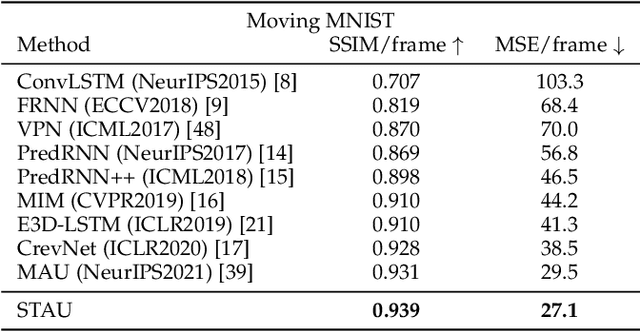
Abstract:Video prediction aims to predict future frames by modeling the complex spatiotemporal dynamics in videos. However, most of the existing methods only model the temporal information and the spatial information for videos in an independent manner but haven't fully explored the correlations between both terms. In this paper, we propose a SpatioTemporal-Aware Unit (STAU) for video prediction and beyond by exploring the significant spatiotemporal correlations in videos. On the one hand, the motion-aware attention weights are learned from the spatial states to help aggregate the temporal states in the temporal domain. On the other hand, the appearance-aware attention weights are learned from the temporal states to help aggregate the spatial states in the spatial domain. In this way, the temporal information and the spatial information can be greatly aware of each other in both domains, during which, the spatiotemporal receptive field can also be greatly broadened for more reliable spatiotemporal modeling. Experiments are not only conducted on traditional video prediction tasks but also other tasks beyond video prediction, including the early action recognition and object detection tasks. Experimental results show that our STAU can outperform other methods on all tasks in terms of performance and computation efficiency.
 Add to Chrome
Add to Chrome Add to Firefox
Add to Firefox Add to Edge
Add to Edge